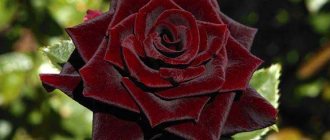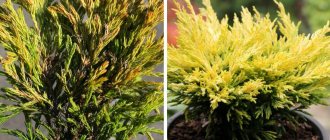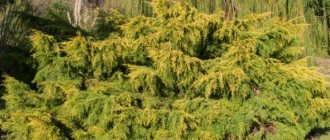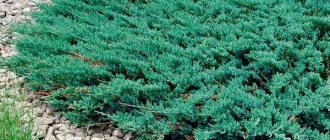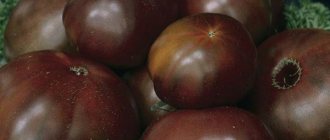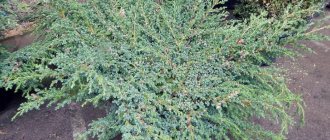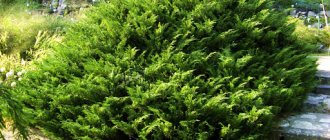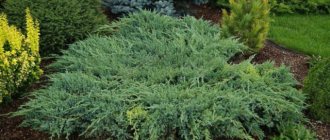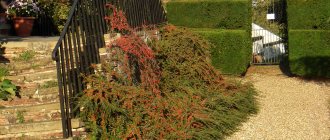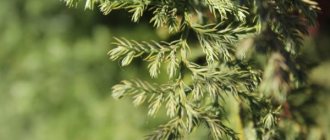Bushes and trees
0
352
Article rating
Kira Stoletova
The horizontal, creeping juniper Prince of Wales is highly decorative and densely covers the soil, creating a dense evergreen carpet. This variety has good winter hardiness, so it is suitable for planting in different regions of our country.
Juniper Prince of Wales
Brief information about the variety
- Color : green needles, scaly.
- Height : 15-20 cm.
- Crown diameter : 2.5 m.
- Cultivation regions : ephedra is cultivated in all regions.
- Planting features : pattern - 50x50 cm. Can grow in sunny and shaded places.
- Immunity : good winter hardiness and high resistance to diseases.
- Life expectancy : no information.
Description of the plant
Juniper horizontalis Prince of Wales is noticeably different from other ground cover varieties.
External parameters:
- height varies from 15 to 20 cm;
- by 10 years the crown reaches 2.5 m in circumference;
- grows slowly - within a year it becomes 1-2 cm taller and 6-8 cm wider.
- the needles are green, scaly, tightly adjacent to the shoots, short - 0.5-1 cm;
- in adulthood, the plant forms spherical, gray-blue cones with a bluish bloom.
Due to its high winter hardiness (it can withstand temperatures down to -30°C), this conifer is cultivated everywhere. In the North, Urals, Central and Central Russia, good insulation is required.
About agriculture
Juniper horizontalis Prince of Wales is a shrub whose branching begins almost from the very root. Each branch is like a separate tree trunk. The shrub tolerates low temperatures well and is remarkably adapted to the climatic conditions of Russia. It has a relatively slow growth rate. Over the course of a year it can increase by 5, maximum 7 cm. It tolerates dry weather well. The plant's needles change from rich green in the summer months to bronze-gold in the winter.
In addition to its remarkable external characteristics, juniper has medicinal properties. Until now, its needles and sawdust, produced from wood, are used in tinctures and decoctions of folk and traditional medicine. Essential oil extracted from juniper has an antiseptic effect on the body. It copes well with bacteria that attack the human respiratory system. In the 18th century, the fruits of the bush were used to treat serious diseases such as malaria, dropsy, nervous system disorders, etc. Also, in addition to using the cones of the plant for medicinal purposes, they are added to many culinary masterpieces. The fruits have an original taste with noticeable sourness. They are used as a spice added to meat and fish dishes. Juniper wood has been in demand in carpentry since ancient times. It is used to make furniture and decorations.
Juniper Prince of Wales
Features of cultivation
Creeping Prince of Wales juniper grows well in all types of soil, so even a novice gardener can cope with it.
The optimal time for planting this crop is the end of April or the beginning of May. By this time, the last frosts will have passed, the earth will warm up to 10-12°C, so the risk of young bushes freezing is minimal.
Selection of seedlings
If you want to get a beautiful and healthy plant with all varietal characteristics, you should buy a seedling from a specialized nursery.
You need to choose taking into account certain criteria.
- It is better to take young specimens, 1-2 years old, with a closed root system. Junipers have very delicate roots that quickly dry out and die as a result of injury. The earthen ball will preserve their integrity until transplanted into the ground. Alternatively, you can purchase bushes planted in pots or containers.
- When purchasing, carefully inspect the above-ground part - it should be alive, without breaks or cracks on the branches.
- In healthy specimens, the needles are rich green in color, fit tightly to the shoots, and do not contain red, yellow or black spots.
Preparing the site and soil
Unlike other varieties, Welsh juniper can grow anywhere in your garden - in sun or partial shade. It tolerates lack of lighting well without losing its decorative qualities.
The planting area should be flat to avoid moisture stagnation and further death of the conifer.
If you do not have such a place, you need to ensure good drainage from vermiculite or sand - 20 kg per 1 m².
When planting on sandy loam soil, you will need to add a couple of buckets of clay. Additionally, two more components are added - peat and humus (3 buckets of each substance per 1 m²). They increase its nutritional value.
Ephedra does not grow well on acidic soil, so 350 g of calcite, dolomite flour or slaked lime are added to the digging. It is not necessary to fertilize the soil with organic and mineral preparations, because This variety develops fully even on poor soil.
Landing technique
Juniper can be grown in shaded areas
When planting this conifer, it is important to adhere to the scheme - 50x50 cm. No more than two seedlings are used per 1 m² - this way they fully develop, do not get sick and remain decorative all year round.
They dig holes slightly larger than the roots, about 60x70 cm. Half a bucket of gravel or brick chips is poured into the bottom, and a nutrient composition of turf soil, peat and sand (2:1:1) is poured onto the top.
Lower the plant together with a lump of earth, sprinkle it with soil mixture, compact it, water it - 5 liters of water per plant. Each seedling is mulched with peat or pine sawdust to avoid rapid drying out of the soil.
When planting, it is important to follow one rule - the root collar must remain above the surface of the soil, otherwise the bush will quickly rot and die.
Features of planting and care
When growing this variety on your site, it is necessary to take into account the need for a certain environment and resistance to adverse factors. Planting should be done in accordance with the agricultural technology of the crop so that the developing Prince of Wales bush receives all the necessary substances. Tolerance to air pollution makes it possible to cultivate juniper within the city.
After planting, it is recommended to provide proper care. The variety grows slowly; lack of nutrition, water or light can slow down development even further. The main activities are carried out in accordance with the time of year and the current growing season. Timely and correctly performed operations will have a beneficial effect on the decorative appearance and immunity of the adult specimen.
Landing
First you need to choose a suitable area for placing the juniper. The culture prefers open sunny places, but the Prince of Wales variety can grow in slight partial shade. It is better to plant the plant on a hill to prevent flooding and waterlogging of the bush. The plant needs moist soil, but excessive moisture will lead to rotting.
The soil for juniper should be loose, drained, with a slightly acidic or neutral reaction. Grows well on sandy loams, poorly on heavy clay soils. It is advisable to dig the planting hole 2-3 times deeper than required to place the earthen ball on the root system of the Prince of Wales. If necessary, pour 20 cm of a mixture of broken bricks and coarse sand onto the bottom. It is recommended to collect the soil mixture from peat, turf and river sand.
Planting is carried out using the transshipment method; the root collar cannot be buried. Lightly compact the surface of the soil along the tree trunk. Water with settled, not cold water, and sprinkle the crown. To reduce moisture evaporation, mulch the soil with any available natural material.
Care requirements
Caring for the Prince of Wales juniper is not difficult and can be done by every gardener.
When planting in a sunny location, plants should be protected from the sun during midday hours. This will protect them from burns, drying out and yellowing.
Agrofibre or burlap is suitable for shading. As soon as they get stronger and begin to grow, the shelter can be removed.
Watering
Regular and frequent watering in the first two weeks is especially important - it speeds up the process of rooting and survival of plants. During the dry period, moisten every other day at the rate of 5 liters per specimen.
Grown bushes can be watered less often - up to 3 times throughout the season.
The needles respond positively to sprinkling with warm water in the evening. Irrigate the above-ground part no more than once a week. If the summer was too hot and dry, the frequency of irrigation is increased to three times every 7 days.
Loosening and mulching
Surface loosening of the soil after watering maintains its moisture and breathability, improves access of oxygen, nutrients and water to the roots.
During this procedure, weeds are removed and weeded between the rows.
Then add mulch from peat or pine sawdust. This layer protects the root system and soil from drying out and prevents the growth of weeds.
Fertilizer
For this plant, nutrition is not as important as for other varieties. The rule here is that it is better to underfeed than to overfeed.
Fertilizer is applied for the first time a year after planting. They use a ready-made mineral composition for conifers at the rate of 120 g per 1 m². To improve the absorption of nutrients, fertilizing is carried out together with watering.
Feed at the initial stage of growth in the spring - at the end of April or in May.
Trimming
Ephedra does not require crown formation, because shoots grow in a chaotic manner and over time create a thick carpet on the soil.
Every spring, before the vegetative buds begin to bloom, a sanitary pruning is carried out - all branches frozen during the winter are removed, as well as shoots damaged by diseases, dry and yellowed parts.
At the age of 10 years, it is worth rejuvenating the bush - carrying out stimulating pruning. This manipulation is best done in the fall (mid or late September). They cut out a third of the total growth of the current year. The cutting is carried out evenly so that the plant can more easily withstand stress.
Trim with a sterile knife, scissors or pruning shears to prevent infection. The cut areas are irrigated with a solution of copper sulfate, and the remains are burned.
Preparing for winter
The variety is frost-resistant
An adult plant tolerates sudden temperature changes and persistent severe frosts well, and therefore does not need shelter, regardless of the growing zone.
The only thing you can do is to cover the tree trunk area with peat (it will serve as protection against drying out and nourish the root system with useful components).
Young specimens aged from 1 to 3 years need good insulation. First, the bushes are mulched with earth or peat, then the above-ground part is covered with spruce branches, a cardboard box or burlap.
Remove the cover in the spring, when the snow thaws and the threat of return frosts has passed.
Rules for caring for juniper
One feature is notable for this type of green space: juniper develops best in poor soil. Based on this, it is worth noting that prince of wales juniper does not like feeding and fertilizing. If you do not pay attention to this feature and frequently feed it, the plant may go wild or even die.
Fertilizers are applied once a year, at the end of spring. When choosing between mineral and organic, preference should be given to the former. In summer, the shrub needs sprinkling, since the needles do not tolerate dry air very well. The plant also needs loosening. This will increase the volume of air that reaches the root system.
Planting juniper Prince of Wales
In winter, young shrubs that are less than three years old should be covered. The material for covering horizontal juniper can be burlap or agrofibre. It is better not to use greenhouse film. Older plants do not require shelter, as they are quite strong. Regardless of age category, all junipers are covered with a 20-centimeter layer of peat during the cold season.
In order for the plant to become more dense and beautiful every year, it is recommended to regularly trim its branches. Pruning is also necessary when the juniper begins to change color from natural green to unnatural white. It is also necessary to remove dry and diseased branches of the plant.
Reproduction methods
Juniper can be propagated in two ways, each of them has advantages and disadvantages.
By layering
In early autumn, a strong and long branch is selected from an adult bush over 5 years old, freed from shoots and needles, and lowered horizontally into a trench.
Pinned with staples, sprinkled with light and fertile soil (peat with sand and turf mixed in equal quantities).
Closer to the onset of stable cold weather, soil is added to protect the shoot from freezing. The next year in the spring, as soon as the plant begins to grow, they dig up cuttings and divide it into segments with several roots and one bud. Planted separately on the site.
Cuttings
For this propagation method, you will need shoots cut from a healthy and mature bush (5-6 years old). Harvesting is carried out during spring pruning.
Use cuttings 1-2 years old, 15-20 cm long with a piece of old wood.
All shoots and needles in the lower part are removed, then sprayed with one of the root formation stimulants (Epin, Kornevin or Heteroauxin), planted in a moist substrate of peat and sand (1:1).
For convenience, use seedling boxes or plastic containers with drainage holes. Planted at an angle of 45° to a depth of 3-4 cm, watered, covered with a transparent film and placed in a warm place with diffused daylight.
The optimal temperature is 20-23°C, after rooting it is lowered to 18-19°C. All care consists of regular ventilation, watering, removing weeds and loosening.
Germination can be considered successful if new buds appear on the cuttings. Then the shelter is removed, watering continues and the soil is loosened. Rooting may take 2 to 3 months.
Transplantation to the site is carried out a year after germination in early autumn, so that the seedlings have time to take root in the new place before the onset of persistent cold weather.
Reproduction of juniperus horizontalis Prince of Wales
The most common method of propagating Prince of Wales juniper is by rooting cuttings. In the spring, the shoot is fixed to the soil, covered with soil on top, making sure that the amount of soil does not decrease, and, if necessary, topping it up. After a year, the plant will form a root system, the cuttings are separated from the bush and planted on the site.
How is hibiscus different from hibiscus and how to grow a Chinese rose at home?
You can propagate juniper by cuttings from shoots. The optimal age of branches for cuttings is 2 years. Planting material is prepared in spring or autumn, the cuttings are placed in fertile soil, and after rooting they are planted.
You can also get a plant by grafting. The method is labor-intensive and rarely used; Prince of Wales juniper does not take root well on a trunk of another species.
The crop can be propagated by seeds, but the planting material of the Prince of Wales hybrid does not retain its varietal characteristics. The result will be a dwarf bush that vaguely resembles the mother plant.
Pests
Juniper has one unique property - it produces natural insecticides that repel many pests. However, unkempt conifers growing in weed thickets can be attacked by parasites or become infected with various infections.
The most common one is aphids. This insect reproduces very quickly, settles in colonies on young shoots, sucking out all the juices from them. As a result, the needles turn yellow and the plant gradually dries out.
You can get rid of this parasite at an early stage of infection using folk remedies - infusion of hot pepper, wormwood, garlic, tobacco or onion. At an advanced stage, three times treatment with Actellik, Aktara or Fundazol is required.
The Prince of Wales is suffering from an infestation of scale insects, spider mites, shoot moths and mealybugs. Systemic insecticides - Fundazol, Enzhio - will help to cope with these insects.
Diseases
Diseased branches need to be removed
Often the needles suffer from rust - a fungal disease that manifests itself in the form of red or yellow growths on the surface of the shoots. Over time, they turn black and the affected organs die.
The main reasons for the appearance of the fungus are frequent waterlogging, thickening of the crown and plantings, and growing next to other conifers.
In order to prevent the disease, it is necessary to treat with copper oxychloride. The same drug is used for medicinal purposes - they irrigate the above-ground part and the soil under it. Alternatively, you can use Bordeaux mixture or copper sulfate solution for treatment.
Sometimes juniper is damaged by powdery mildew - a whitish coating on the surface of the needles and shoots becomes wet and then rots. Infected parts die. To fight, take Bordeaux mixture at 2% concentration.
Beneficial properties of juniper
When planting a coniferous specimen on their site, many are interested not only in its external characteristics, but also want to know how juniper is useful in order to find more practical uses for the plant. This green conifer has a pleasant aroma. It contains many active ingredients that have antiseptic and antibacterial properties. Therapeutic essential oils, monoterpenes, vitamins and microelements of juniper allow it to be used as a preventive measure for many ailments.
The fruits of this amazing conifer are juniper berries. Distinguished by their dark blue color, they look like both cones and berries at the same time. The use of juniper fruits as a universal medicinal product has long been in great demand. It was used for various purposes. In ancient times, the properties of juniper made it possible to treat malaria and dropsy, rheumatism and mental diseases.
Today, juniper berries can be taken as an extract, infusion, decoction, or in powder form.
In addition, the fruits of coniferous shrubs are widely used in cooking. Used as a spice, the berries add a special taste to meat and fish dishes, as well as poultry. These fruits can be useful not only as an aromatic seasoning, but also in the production of alcoholic beverages.
Shrub wood has found special application. It has unique qualities: unusual texture, flexibility and softness, ease of processing. Since ancient times, wood has been used as a material to create beautiful and original furniture, interior items and decorations. Look at the article about growing indoor juniper.
Application in garden design
The Prince of Wales variety is one of the most valuable in landscape design; thanks to its dense branching, juniper creates unusual decorations in the garden:
- used in single and group plantings with low-growing ornamental flowering and deciduous flowers;
- planted in flower beds, used as an additional element in rocky and rocky areas;
- looks beautiful in rockeries, ridges, rock gardens, next to the gazebo or near the terrace;
- creates a living and evergreen carpet on any lawn;
- goes harmoniously with small deciduous trees and shrubs.
